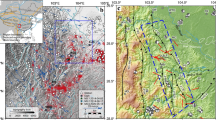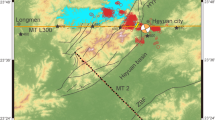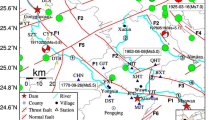Abstract
We built a high-resolution Boussinesq water-load model for the Badong County section of the Three Gorges Reservoir by referring to Google Earth image data for different years. We also analyzed the focal mechanism of some significant earthquakes, Coulomb stress, coda spectrum, the precise location of small earthquakes, and the characteristics of seismicity migration. Based on these investigations, we explain the seismogenic mechanism of earthquakes (from 2003 to now) in Badong County and trace the evolution of earthquakes in the reservoir area before and after impoundment on a NE–SW transect. Some preliminary findings are listed as follows: (1) The calculation results show that the hydraulic or Coulomb stress caused by the direct water load in the reservoir area is not the main reason for the continuous occurrence of earthquakes in recent years; in other words, the direct effect of hydraulic stress only plays a secondary role. (2) The migration and evolution of seismicity, together with the variation of coda spectrum density, suggest that the characteristics of different stages of fluid infiltration are obviously different. With the influence of continuous infiltration, earthquakes have occurred from shallow to deep, from scattered to crowded, and have gradually approached deeper and larger faults. In addition, the high-frequency energy released by these earthquakes increased. (3) Compared with the Wenchuan MS 8.0 and Xinfengjiang MS 6.1 earthquake, no earthquakes larger than MS 5.2 have occurred in the Badong and Zigui areas in the past 17 years, which far exceeds the time lag between the two mentioned strong earthquakes and impoundment of the respective reservoirs. This finding indicates that the occurrence of strong earthquakes near the reservoir area is mainly controlled by the risk level of original strong earthquakes, while fluid infiltration only provides a certain induction effect. (4) More attention should be paid to the role of invisible water in the process of seeping into the strata on both sides of the river. We conservatively estimate that the amount of invisible fluid infiltrating on both sides may be 15.1% greater than the visible water in the study area. Therefore, more careful analysis of geological disasters (e.g., landslides and earthquakes) caused by fluid infiltration of a long, narrow, and sharply sloped river after artificial impoundment is indeed required.















Similar content being viewed by others
References
Bell, M. L., & Nur, A. (1978). Strength changes due to reservoir induced pore pressure and stresses and application to Lake Oroville. Journal of Geophysical Research Solid Earth, 83, 4469–4483.
Chai, B., & Yin, K. L. (2009). Interlayer weakness zones in Badong formation of middle trassic forming bank slopes of Three Gorges reservoir in new Badong county. Journal of Engineering Geology, 17, 809–816. In Chinese with English abstract.
Chang, T. G., & Hu, X. (2018). Research progress on reservoir induced earthquake. Journal of Hydraulic Engineering, 49, 1109–1122. In Chinese with English abstract.
Chen, S. J., Yao, Y. S., & Zeng, Z. X. (2005). Effect of impounding on seismogenic environment and potential focus in head region of Three Gorge reservoir. Journal of Geodesy and Geodynamics, 25, 116–120. In Chinese with English abstract.
Chen, Y. (2009). Wenchuan Earthquake is triggered by reservoir storage? Scientia Sinica Terrae, 39, 257–259. In Chinese with English abstract.
Gough, D. I., & Gough, W. I. (1970). Stress and deflection in the lithosphere near Lake Kariba-1. Geophysics Journal International, 21, 65–78.
Du, R. L., Qiao, X. J., & Yang, S. M. (2004). The results of GPS treatment and the strain field in the three gorges of the Yangtze River. Geomatics and Information Science of Wuhan University, 29, 768–771. In Chinese with English abstract.
Farrell, W. E. (1972). Deformation of the earth by surface loads. Reviews of Geophysics and Space Physics, 10, 761–797.
Geoffrey, C. P. K., Ross, S. S., & Lin, J. (1994). Static stress changes and the triggering of earthquakes. Bulletin of the Seismological Society of America, 84, 935–953.
Gu, X. L., Qian, H. J., Liu, H. S., & Wang, S. M. (2003). Subgrade and foundation (p. 142). China Architecture and Building Press.
Hu, D. S. (2016). An analysis of the geodynamical evolution and geological structural environment in the Yangtze Gorges project. Acta Geoscientica Sinica, 37, 626–636. In Chinese with English abstract.
Hua, W., Chen, Z. L., Zheng, S. H., & Yan, C. Q. (2010). A study on characteristics of source parameters in Three Gorges reservoir area. Seismology and Geology, 32, 533–542. In Chinese with English abstract.
Huang, R., Zhu, L. P., Encarnacion, J., Xu, Y. X., Tang, C. C., Luo, S., & Jiang, X. (2018). Seismic and geologic evidence of water-induced earthquakes in the Three Gorges reservoir region of China. Geophysical Research Letters, 45, 5929–5936.
Hubbert, M. K., & Rubey, W. W. (1959). Role of fluid pressure in mechanics of over thrust faulting. Geological Society of America Bulletin, 70, 167–206.
Lei, X. L., Ma, S. L., Wen, X. Z., Su, J., & Du, F. (2008). Integrated analysis of stress and regional seismicity by surface loading—a case study of Zipingpu Reservoir. Seismology and Geology, 30, 1046–1064. In Chinese with English abstract.
Li, C., Yu, P., Li, B., & Chen, Y. B. (1997). Factor analysis of rationally selection optional excitation condition for dynamite source. Geophysical Prospecting for Petroleum, 36, 105–111. In Chinese with English abstract.
Li, S. L., Yan, Z. G., & Xue, J. R. (2003). First microquake swarm activity since storage in Three Gorges reservoir. Journal of Geodesy and Geodynamics, 23, 75–79. In Chinese with English abstract.
Li, P., & Li, Y. J. (2004). Study on the crustal stability in Three Gorges area of the Yangtze River. Engineering Science, 6, 26–34. In Chinese with English abstract.
Li, X., Li, J. G., Liu, X. L., & Wang, Q. L. (2016). The spatial distribution characteristics and risk assessment of landslides in the head region of the Three Gorges reservoir. Journal of Geodesy and Geodynamics, 36, 630–634. In Chinese with English abstract.
Li, J. G., Zhang, L. F., & Liao, W. L. (2018). Earthquakes in the fold structure—the genesis of the M4.3 earthquake sequence in the Three Gorges reservoir area in 2017. Chinese Journal of Geophysics, 61, 3701–3712. In Chinese with English abstract.
Liang, X. X., & Du, R. L. (2008). Numerical simulation of vertical crustal deformation in Three Gorges area based on SRTM. Journal of Geodesy and Geodynamics, 28, 38–43. In Chinese with English abstract.
Lin, J., & Stein, R. S. (2004). Stress triggering in thrust and subduction earthquakes and stress interaction between the southern San Andreas and nearby thrust and strike-slip faults. Journal of Geophysical Research, 109, B02303. https://doi.org/10.1029/2003JB002607
Nikolaev, N. (1974). Tectonic conditions favourable for causing earthquakes occurring in connection with reservoir filling. Engineering Geology, 8, 171–189.
Snoke, J. A. (2003). Focmec: Focal mechanism determinations. International Geophysics, 81, 1629–1630. https://doi.org/10.1016/S0074-6142(03)80291-7
Sun, S. A. (2004). High precise gravity survey before and after impoundment of Three Gorges reservoir. Journal of Geodesy and Geodynamics, 24, 30–33. In Chinese with English abstract.
Talwanip, P., & Acrees, S. (1984). Pore pressure diffusion and the mechanism of reservoir-induced seismicity. Pure and Applied Geophysics, 122, 947–965.
Waldhauser, F., & Ellsworth, W. L. (2000). A double-difference earthquake location algorithm: Method and application to the northern Hayward fault. Bulletin of the Seismological Society of America, 90, 1353–1368.
Wang, M. Y., Yang, M. Y., Hu, Y. L., Li, Z. Q., Chen, Y. T., Jin, Y., & Feng, R. (1976). Mechanism of the reservoir impounding earthquakes at XinFengJiang and a preliminary endeavor to discuss their cause. Acta Geophysica Sinica, 19, 1–17. In Chinese with English abstract.
Wang, L. S., Chen, C., & Ma, X. (2016). A water storage loading model by SRTM-DEM data and surface response simulation of gravity and deformation in the Three Gorges reservoir of China. Acta Geodaetica Et Cartographica Sinica, 45, 1148–1156. In Chinese with English abstract.
Wu, H. B., Shen, X. L., & Wang, J. (2018). Three-dimensional velocity structure of upper crust in the Three Gorges reservoir area derived from double-difference tomography. Chinese Journal of Geophysics, 61, 2802–2814. In Chinese with English abstract.
Xiao, S. R. (2002). Research on engineering utilization of weathered rock mass in Three Gorge Dam Area. Journal of China Three Gorges University, 24, 210–213. In Chinese with English abstract.
Xiao, S. R., Liu, D. F., Jiang, F. X., & Jiang, X. L. (2010). Geomechanical model experiment on Qianjiangping landslide in Three Gorges reservoir area. Chinese Journal of Rock Mechanics and Engineering, 29, 1023–1030. In Chinese with English abstract.
Yao, Y. S., Wang, Q. L., Liao, W. L., et al. (2017). Influences of the Three Gorges Project on seismic activities in the reservoir area. Science Bulletin, 62, 1089–1098.
Yu, P. Q. (1993). Discussion on the possible tectonic earthquake in Changjiang Three-Gorge reservoir area in relation to hydrogeologic conditions. South China Journal of Seismology, 13, 76–83. In Chinese with English abstract.
Zeng, Y. H., Su, F., & Aki, K. (1991). Scattering wave energy propogation in a random isotropic scattering medium. Journal of Geophysical Research, 96, 607–619.
Zhang, L. F., Li, J. G., Wei, G. C., Liao, W. L., Wang, Q. L., & Xiang, C. F. (2017). Analysis of the relationship between water level fluctuation and seismicity in the Three Gorges reservoir (China). Geodesy and Geodynamics, 8, 96–102.
Zhou, B., Xue, S. F., & Deng, Z. H. (2010). Relationship between the evolution of reservoir-induced seismicity in space-time and the process of reservoir water body load-unloading and water infiltration—a case study of Zipingpu reservoir. Chinese Journal of Geophysics, 53, 2651–2670. In Chinese with English abstract.
Acknowledgements
The authors thank the national seismological network data backup center in China (Institute of Geophysics, CEA) for providing seismic waveform data. We also express our heartfelt thanks to Professor Wang Rongjiang of The German Research Center for Geoscience to his theoretical and methodological guidance on 3D tensor rotation and Coulomb stress calculation. Additionally, we convey our gratitude to the two anonymous reviewers for many valuable suggestions.
Author information
Authors and Affiliations
Corresponding author
Additional information
Publisher’s Note
Springer Nature remains neutral with regard to jurisdictional claims in published maps and institutional affiliations.
Rights and permissions
About this article
Cite this article
Liu, S., Xue, Y. & Wang, Y. Analysis of Seismicity Characteristics and Seismogenic Mechanism in Badong County of Three Gorges Reservoir Area Before and After Impoundment. Pure Appl. Geophys. 179, 83–104 (2022). https://doi.org/10.1007/s00024-021-02914-9
Received:
Revised:
Accepted:
Published:
Issue Date:
DOI: https://doi.org/10.1007/s00024-021-02914-9




